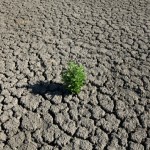This Week in Drought: Time to Wake Up and Smell the Scarcity
New numbers out this week show an increasing percentage of Texas facing drought conditions, according to the US Drought Monitor Map. More than 96 percent of the state is classified as at least “abnormally dry.” That’s an 8 percent increase in the past week.
State climatologist John Nielsen-Gammon warned on his blog earlier this week that Texas reservoir levels are back to where they where in August 2011, near the peak of the drought. “If the drought continues as I have depicted it, [by] the end of the summer it will be the second-worst drought on record, behind only the drought of the 1950s,” Nielsen-Gammon writes.
In a series of disturbing charts, Nielsen-Gammon shows that precipitation trends for the current water year (which began in October) are much closer to the extreme drought of 2011 than a normal year, and predicts reservoir levels in the state will drop below 50 percent in September. The Texas Water Development Board shows reservoir levels in Texas currently at just over 66 percent.
If the drought does continue, cattle ranchers are in for a summer similar to that of 2011, when they suffered over $3 billion in losses. Some South Texas farmers have already had to resort to an emergency method of feeding their cattle, and it’s not cheap.
“Once a drought starts drying up the natural resources of a ranch, expenses and efforts increase tremendously. Equipment gets more use which means added repairs and maintenance; the list just goes on and on,” Texas A&M AgriLife Extension Service Agent Omar Montemayor says in a new Agrilife report.
Many ranchers burn the spines off prickly pear cactus to feed to their cattle and give them water, a process known in Spanish as chamuscando. This method requires propane to burn the spines, which is an added cost, and the purchasing of protein pellets to supplement their animals’ diets. Often, ranchers also need to ship water and hay to their land for their herds, which is becoming more and more expensive.
“Our ranchers are not youngsters,” Montemayor said in the Agrilife report. “The expense and effort they have to put in is taking a terrible toll. With little or no rain since Hurricane Alex in 2010, and none in the forecast, we could be looking at the end of an era here. Ranchers, like farmers, are very optimistic, but how long can they hold out?”
The latest 3-month drought outlook from the National Oceanic and Atmospheric Administration (NOAA) released today calls for the drought to “persist or intensify” in almost all of the state, and to develop in most of the few remaining areas that are currently drought-free or in the lowest stages.
“Many places, probably in eastern Texas, will be still have plenty of water available from reservoirs,” Nielsen-Gammon wrote this week. “But other places, mostly in central and West Texas, will do much worse.”
A plan that would provide significant funding for new water supply projects is currently making its way through the legislature. HB 4, by Rep. Allan Ritter, R-Nederland, recently passed a committee vote unanimously, and will have a hearing on the House floor on Wednesday.


